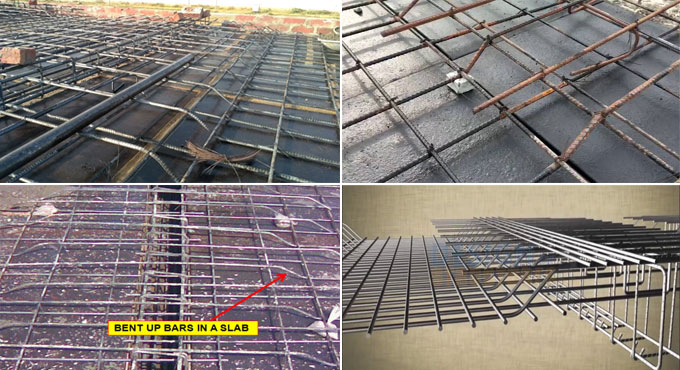
Benefits of crank bars in slabs
Crank bars alias bent up bars are provide in R.C.C ended Slabs where the column remains at the ends of the supports. In these slabs, the following types of moments are produced :-
1. The positive moment alias Sagging that is formed at mid of the span.
2. The negative moment alias Hogging that is formed at the supports.
The continuous beam, overhanging beam, etc. undergo two types of the bending moments positive and negative and in order to withstand these moments in beams & slabs, the bars are arranged.
BENT UP BARS:
1. Bent-up bars alias Crank bars are arranged in the ends on the top of the slab or also in the top of the mid supports (in case of existence of any mid-support) to resist the negative moment known as Hogging that is formed at that sections of the slabs and beams.
2. Several Angles on the crank bar called as bends, is arranged in the slabs. In some situations, straight bars are arranged at the end on the top of the slab and in some cases, the crank bars are set at 45? angle. In some cases, the 30? bent is allowed in case shallow beams exist at the end of the slabs.
3. Usually, the length of the crank bar remains minimum 300 millimeters and the slope or bend on the crank bars (Bent up bars) remain in the ratio 1: 10.
4. With crank bars in the R.C.C slabs, the stability of the slab is raised significantly as compared to the slabs where crank bars are not found.
5. The distance among the main bars with a diameter of 12 mm or 10 mm should remain 6 inches center to center c/c and if 8 mm diameter bars are utilized, the distance should be 4 inch center to center c/c.
6. The distance of distribution bars with a diameter 10 mm should remain 9 inches to 12 inches center to center c/c. For 8 mm diameter bar, the distance 7 inches to 9 inches center to center c/c. The distance is also based on the extent and thickness of slab.
Benefits of crank bars in slabs:
1. To withstand Hogging (Negative Bending Moment) at supports.
2. To check the risk of the failure of the slabs.
3. To combat the shear force. The shear remains high in the sections of supports.
4. Raise the strength of the slab.
The crank bars or bent up bar play a vital role in R.C.C beam or slabs construction as without defending the Hogging (Negative moment) the structure may collapse or the strength of the structure is decreased significantly.
The hogging bending moment is created at the supports of the slabs and beams.


